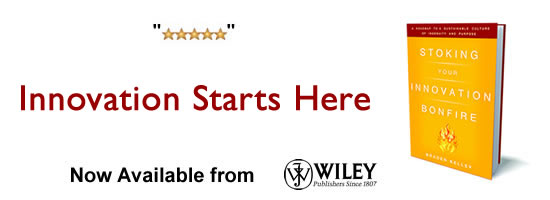Key Innovation Lessons from the Nuclear Industry
 One of my favorite parts about writing about innovation is receiving insightful comments from readers with diverse experiences and perspectives. Recently, a junior colleague with expertise in organizational research, learning, and performance made a connection between my previous article on the need to de-risk innovation and the key traits of high-reliability organizations (HROs). HROs, such as nuclear power generation and air traffic control, are high-risk by nature operating in areas where accidents are likely due to complexity and the consequences of failure are severe. However, many HROs have long track records of successful operations despite these risks. There has been a recent push from other industries such as healthcare to adopt the HRO framework to improve operations when the risks and consequences of failure are high. Here’s an excellent article from Becker’s Hospital Review describing the five primary traits of HROs and how to apply them to increase the reliability of health care delivery.
One of my favorite parts about writing about innovation is receiving insightful comments from readers with diverse experiences and perspectives. Recently, a junior colleague with expertise in organizational research, learning, and performance made a connection between my previous article on the need to de-risk innovation and the key traits of high-reliability organizations (HROs). HROs, such as nuclear power generation and air traffic control, are high-risk by nature operating in areas where accidents are likely due to complexity and the consequences of failure are severe. However, many HROs have long track records of successful operations despite these risks. There has been a recent push from other industries such as healthcare to adopt the HRO framework to improve operations when the risks and consequences of failure are high. Here’s an excellent article from Becker’s Hospital Review describing the five primary traits of HROs and how to apply them to increase the reliability of health care delivery.
Innovation is inherently high-risk. Cultivating the traits of a high reliability organization within your innovation program can improve your success rate.
While in my previous post we discussed the importance of defining acceptable failure to de-risk innovation for individuals, we should also acknowledge that it is best for both the organization and the individual innovator to minimize the chances of failure. While the failure of an innovative initiative will likely be less catastrophic than a failure in nuclear power generation, air traffic control, or hospital care, there are key lessons for an innovation program to learn from HROs.  Here’s a brief look at some ways the key principles of a successful HRO can be applied to improve the performance of an innovation program:
- Preoccupation with failure: Innovation programs often assume that high failure rates come with the territory, and this can lead to inadequate examination and learning from failures. In contrast, HROs are obsessed with not only actual failures but also with near misses and how things could fail in the future. The obsession is less about assigning blame to an individual for a mistake than about thoroughly examining operational support processes, training, and technologies to minimize the chances of human error. Too often, innovation programs rely on motivated and talented individuals to carry initiatives forward (or to fail in that endeavor) without critically assessing how the support structures affected the likelihood of success.
- Reluctance to simplify: Getting innovation from concept to implementation at scale is complex with multiple opportunities for promising initiatives to be sidetracked or fail. When diagnosing innovation challenges in an organization, it is easy to fall into the trap of simple explanations like inadequate funding or not enough time available without digging deeper into root causes. HROs embrace complexity and refuse to explain away problems with simple diagnoses when the underlying issues are likely much more nuanced and difficult to resolve.
- Sensitivity to operations: Innovation initiatives ultimately succeed or fail based on the actions of the front line employees who are driving them. It is relatively straightforward for organizational leadership to give lip service to innovation and even establish general processes, structures, and funding for advancing initiatives. It is far more difficult to consistently listen to front line innovators and adapt approaches based on their realistic assessment of obstacles and failure points as opposed to senior leadership’s idealized perceptions of how it is supposed to work. HROs understand that frontline employees have the most accurate perspective on current operations and are best positioned to recognize likely failure mechanisms as well as improvement opportunities.
- Commitment to resilience: Innovation initiatives are exciting topics for organizational leadership to discuss. Organizations love to promote their innovative work and the processes they have put in place to foster internal and external innovation. However, an organization’s true commitment to innovation can be severely tested if early initiatives fail, if investment costs are not immediately justified with quantifiable returns, or if key innovation leaders leave. HROs are committed to building resilience that enables adaptive and effective response to failures, finds new solutions or approaches to unexpected issues, and ensures that response capabilities run deeper than isolated staff members. The most successful innovation programs prioritize resilience to ensure success and survival over time as the organization and staff evolve.
- Deference to expertise: Successful innovation programs deploy the right expertise to solve problems without being restricted by formal organizational leadership hierarchies or structures. One risk of establishing dedicated innovation teams or labs is that critical domain or technical expertise (particularly from more junior staff) may be inadvertently omitted from the innovation cycle leading to sub-optimal solution development. HROs prioritize expertise over authority, seniority, or organizational structure to bring the most relevant input to identifying and solving high priority issues.
Innovation programs that are pushing the frontier of new products and services to deliver value to internal and external stakeholders will inevitably yield some failures. Organizations that define acceptable failure de-risk innovation for individuals. The best innovation programs go even further by adopting the principles of HROs to increase the likelihood of successful outcomes in a high-risk environment.
Wait! Before you go…
Choose how you want the latest innovation content delivered to you:
- Daily — RSS Feed — Email — Twitter — Facebook — Linkedin Today
- Weekly — Email Newsletter — Free Magazine — Linkedin Group
 Dr. Michael “Whit†Whitaker is Vice President of Emerging Solutions for ICF International. He is responsible for fostering a culture of innovation where creative thinking, experimentation, prototyping, rapid iteration, and deep understanding of markets, clients, and end-user needs are used to develop new solutions that drive growth and customer satisfaction in rapidly emerging markets. Follow Whit on Twitter or connect on LinkedIn
Dr. Michael “Whit†Whitaker is Vice President of Emerging Solutions for ICF International. He is responsible for fostering a culture of innovation where creative thinking, experimentation, prototyping, rapid iteration, and deep understanding of markets, clients, and end-user needs are used to develop new solutions that drive growth and customer satisfaction in rapidly emerging markets. Follow Whit on Twitter or connect on LinkedIn
NEVER MISS ANOTHER NEWSLETTER!
LATEST BLOGS
Three things you didn’t know about credit cards
Photo by Ales Nesetril on Unsplash Many of us use credit cards regularly. From using them for everyday purchases to…
Read MoreFive CV skills of a business-minded individual
Photo by Scott Graham on Unsplash The skills listed on a CV help employers quickly understand your suitability for a…
Read More


